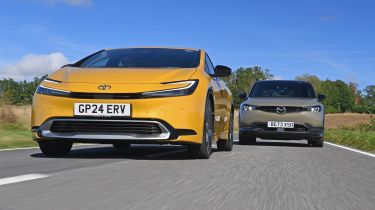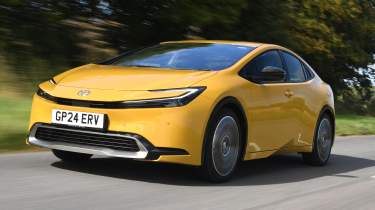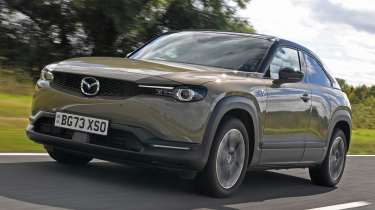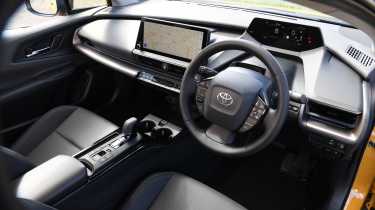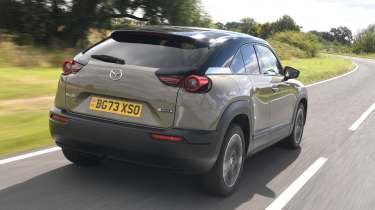Toyota Prius vs Mazda MX-30: a Japanese hybrid car clash
The new Toyota Prius is a PHEV, while Mazda’s MX-30 R-EV is a rotary-engined range extender. Which takes charge here?
The Toyota Prius is a household name these days, famous for pioneering hybrid technology in the nineties and taking it into the mainstream in the 2000s.
However, it’s never been one to make tech cool; it’s known as something of an ugly duckling, thanks to its all-in approach to aerodynamics, which has given us some odd-looking cars over the years.
The duckling has finally turned into a swan with this new-generation car, though; it’s hard to argue it’s not the best looking Prius ever. You might even call it the sharpest car in Toyota’s range at the moment, but is there still a good car underneath the new body?
To find out, we’ve put the plug-in hybrid Prius alongside a rival that is getting fans excited, the Mazda MX-30 R-EV. It marks the return of a rotary engine, a type of motor that was previously used in sports cars rather than hybrids. Now Mazda has found a new way to deploy its signature tech, as a range-extender for an electric car. We’ll dive into how it works later.
So while Toyota has gone for a new look but left the Prius hybrid powertrain alone, Mazda has put an innovative one into an MX-30 that looks no different to the electric model.
Toyota Prius
| Model: | Toyota Prius Plug-In Excel |
| Price: | £39,955 |
| Powertrain: | 4cyl inline/1,987cc petrol engine, plus 1x e-motor, CVT auto, 220bhp |
| 0-62mph: | 6.8 seconds |
| Test efficiency: | 80mpg |
| Official range: | 739 miles |
| Annual VED: | £180 |
The Toyota Prius was revealed in 2022 in Japan, with no plans to bring it to the UK at the time. But it’s finally available in plug-in hybrid form from £37,315 (the Excel model here starts at £39,955).
Used - available now

2020 Toyota
Prius
34,796 milesAutomaticPetrol1.8L
Cash £16,100
2020 Toyota
Prius
17,385 milesAutomaticPetrol1.8L
Cash £18,991
2012 Toyota
Prius
81,769 milesAutomaticPetrol1.8L
Cash £8,190
2018 Toyota
Prius
29,320 milesAutomaticPetrol1.8L
Cash £14,485While the exterior is new, the platform is the same as with the previous generation. It was already efficient and comfortable, and there have been improvements to the tech as well. For example, with a total of 220bhp from its 2.0-litre engine and electric motor, this is the fastest Prius yet.
Tester's notes
We continue to be impressed by the Prius’s efficiency in the real world. Many plug-in hybrids have mpg figures in the hundreds thanks to the official tests but in reality, you can expect fairly normal numbers from them. We jumped into this new Prius and drove normally in hybrid mode, seeing 88mpg without much effort at all. After our test, the car hadn’t dropped below 80mpg at any point, which just shows how a focus on making a car efficient can pay off. Yet the Prius does this while being fun to drive, comfy and even quite stylish.
Mazda MX-30
| Model: | Mazda MX-30 R-EV Makoto |
| Price: | £36,445 |
| Powertrain: | 830cc rotary engine, single-speed auto, 168bhp |
| 0-62mph: | 9.1 seconds |
| Test efficiency: | 44mpg |
| Official range: | 462 miles |
| Annual VED: | £180 |
The Mazda MX-30 R-EV starts at £31,495 (our Makoto-trim model costs £36,445), so it undercuts its rival on price. It’s also different in execution, because although both are plug-in hybrids, the MX-30’s engine never drives the wheels. It’s a range extender, meaning the engine only charges the battery. We’ll see how that compares to the Prius, which has a more conventional set-up, below. The MX-30 R-EV is taller that the Toyota but only has part rear-opening doors.
Tester's notes
Our MX-30 R-EV test car arrived with a full battery and fuel tank, but after a whole day of driving it was showing mid-forties miles per gallon. That was half what the Prius plug-in was returning, which suggests that the MX-30 isn’t really the best option for those looking for a car to be used on longer trips. It’s really meant to be used as a commuter car with the ability to go on longer trips occasionally, because you’ll really need to make the most of that 50 or so miles of electric-only range for this Mazda to ever work out as cheap to run.
Head-to-head
On the road
The Toyota’s output of 220bhp means it’s the faster of the two cars, but both are punchy from low speeds and quiet in town. However, the rotary engine in the Mazda is more audible when it kicks in to charge the battery. Both cars are more enjoyable to drive than they look, offering good road-holding and impressive comfort over bumps and potholes. High-quality engineering in both shines through in the way they drive.
Tech highlights
Toyota pairs an efficient 2.0-litre petrol engine with an electric motor using a 13.6kWh battery and CVT automatic transmission. The Mazda’s rotary engine charges a larger 17.8kWh battery and the front wheels are driven by a 168bhp electric motor. While Mazda’s ethos with the MX-30 EV was to reduce weight, it’s actually heavier than the Prius in R-EV form, even though the engine itself is a tiny 830cc single-rotor unit.
Price and running
The Toyota is more expensive to buy, although both makers are offering good finance packages on these cars. However, in our test the Prius proved more efficient than the MX-30 in hybrid mode, returning well over 80mpg without much effort. We didn’t test them with an empty battery, but in the real world you should aim to charge both of these cars overnight and make the most of their small battery capacity.
Practicality
Compormised practicality is a common theme for this test, but in different ways for each model. While the Toyota has decent legroom in the back, headroom isn’t good for taller adults and the boot is high and quite small. The Mazda’s load bay is better, but rear-seat legroom is poor and access is tight. At least the front seats in both cars are comfortable and roomy enough even for taller drivers.
Safety
Euro NCAP hasn’t tested the new Prius yet, but it has all the tech you’d expect in a modern car. The Mazda received a five-star rating in 2020 for the EV version. Adaptive cruise control is standard on both and works well in each case. The Mazda beats the Toyota for parking tech because it comes with a 360-degree surround-view camera, whereas the Prius only has a reversing camera showing the view from the rear.
Ownership
Both manufacturers fared well in the 2024 Driver Power customer satisfaction survey, so ownership should be excellent no matter which you choose. Toyota’s unique warranty system means it’s one of the best car makers in the UK for long-term ownership, because each dealer service extends the warranty by a year for up to 10 years. There’s no reason to expect either to be unreliable if well maintained.
Verdict
First place: Toyota Prius
The Toyota Prius is more expensive than its rivals but it’s well worth spending a little more to stretch to it in this case. Both cars are enjoyable to drive and have a comfortable ride, but the Toyota has a quieter engine and enjoys far more impressive performance.
It’s also a lot more efficient than the MX-30, has a better warranty and substantially better residual values. The stylish looks mean it’s the most appealing Prius ever made – a real eye-opener and a big step forward for the Japanese brand, even if we did have to wait a while for this version to come to the UK.
Second place: Mazda MX-30
We love the innovative nature of the MX-30 R-EV. Tasking the engine with charging the battery means it’s a lot more practical than the pure-EV model and the interior is fantastic. It’s also great to drive and comfortable at any speed, and performance is good around town.
However, it’s not as quick as the Prius, nor is it as quiet because the engine is too noisy when it kicks in. The MX-30 looks like it should have the Toyota beaten for practicality because of its SUV-like shape, but it’s no more spacious inside than its rival, and its running costs are likely to be higher than the Toyota’s as well.
Prices and specs
| Toyota Prius | Mazda MX-30 R-EV | |
| Our choice | Toyota Prius Plug-in Excel | Mazda MX-30 R-EV Makoto |
| Price from/price of our choice | £39,555/£40,610 | £35,895/£36,445 |
| POWERTRAIN AND PERFORMANCE | ||
| Engine | 4cyl in/1,987cc | Single-rotor/830cc |
| HEV Motor | 161bhp | 168bhp |
| Power | 220bhp | 168bhp |
| Torque | 190Nm | 260Nm |
| Transmission | CVT auto/fwd | Single-speed auto/fwd |
| 0-62/topspeed | 6.8 secs/109mph | 9.1 secs/87mph |
| Fuel tank/battery capacity | 40 litres/13.6kWh | 50 litres/17.8kWh |
| MPG (WLTP)/range | 353.1mpg/739 miles | 282.5mpg/462 miles |
| DIMENSIONS | ||
| Length/wheelbase | 4,599/2,750mm | 4,395/2,655mm |
| Width/height | 1,782/1,430mm | 1,795/1,555mm |
| Boot space (seats up/down) | 284/N/A litres | 332/1,137 litres |
| Kerbweight/ towing weight | 1,560kg/N/A | 1,731kg/N/A |
| Turning circle | 11.5 metres | 11.4 metres |
| COSTS/OWNERSHIP | ||
| Residuals (3yrs/36k miles) | £23,554 | £10,609 |
| Depreciation | 29.1% | 58.0% |
| Insurance group/quote/VED | 31/£1,112/£180 | 23/£1,056/£180 |
| Three-year service cost | £28pm/£1,008 | £26pm/£936 |
| Annual tax liability std/higher rate | £638/£1,277 | £573/£1,147 |
| Annual fuel cost (10k miles) | £784 | £1,567 |
| Basic warranty (miles)/recovery | Up to 10yrs (100,000)/1 yr | 3yrs (60,000)/3 yr |
| Driver Power manufacturer position | 8th | 7th |
| Euro NCAP Adult/child/ped./assist/stars | N/A | 91/87/68/73/5 (2020) |
| EQUIPMENT | ||
| Metallic paint/wheel size | £655/19 inches | £550/18 inches |
| Parking sensors/reversing camera | F&r/rear | F&r/360 |
| Spare wheel/Isofix points | Repair kit/2 | Repair kit/2 |
| Keyless entry & go/powered tailgate | Yes/yes | Yes/no |
| Leather trim/heated seats | Faux/yes | Faux/yes |
| Screen size/digital dashboard | 12.3 inches/yes | 8.8 inches/yes |
| Climate control/panoramic sunroof | Yes/no | Yes/yes |
| USB count/wireless charging | Six/no | Two/yes |
| Wireless CarPlay/Android Auto | Yes/yes | Yes/yes |
| Blind-spot warning/head-up display | Yes/no | Yes/yes |
| Adaptive cruise control/steering assist | Yes/yes | Yes/yes |
What we would choose
Toyota Prius
Your only choice here is the paint colour, which costs £655 for most shades, or £950 for red or white. We like the yellow our test car came in, but it’s not likely to be a common choice and even the standard-spec blue looks good.
Mazda MX-30
The Mazda’s dull paint colours cost £550 and you need to pay £1,800 for the (admittedly stunning) Soul Red option, which is very steep. We’d choose cloth seats over the leather ones since they look and feel smarter.

